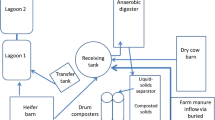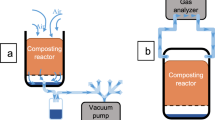Abstract
Approximately 1.1 million deer–vehicle collisions occur in the United States each year. The predominant methods of disposing of these carcasses (landfill and burial) have several costly disadvantages, including long travel distances to landfills, increasing landfill restrictions, and lack of viable burial areas. Some states have found static compost windrows to be an easy and cost-effective carcass management technique. This type of composting involves the construction of passively aerated static piles, which do not require the materials turning needed with more traditional composting methods. In this study, deer mortality static compost windrows were monitored for 1 year. Windrows were analyzed for pathogen destruction and the degree to which underlying soil filtered leachate contaminants. In response to high windrow temperatures, indicator pathogens Escherichia coli and Salmonella were reduced by 99.99 % the first sampling day (day 7) and ascarids were deemed non-viable by day 77. Soil filtration of leachate was effective in reducing concentrations of ammonia, chloride, and total organic carbon. Nitrate, a contaminant of particular regulatory concern, had an estimated mass contaminant loss of 2.1 kg/ha, compared to the estimated 9 to 50 kg/ha loss from fertilizer application of common agronomic crops. Results of this study indicate that with properly constructed static compost windrows, (1) high temperatures effectively destroy indicator pathogens; (2) the natural filtration of leachate through soil reduces deer mortality contaminant concentrations; and (3) the low volume of leachate (i.e., two percent of the precipitation that fell on windrows) results in nominal losses of nitrate and other contaminants.













Similar content being viewed by others
References
Allison, F. E. (1966). The fate of nitrogen applied to soils. Advanced Agronomics, 18, 219–258.
Amies, C. R. (1967). A modified formula for the preparation of Stuart’s transport medium. Canadian Journal of Public Health, 58, 296–300.
Arroyo-Rodriguez, A. (2009). Composting road-killed deer. Biocycle. 31–32.
Ballestero, T. P., & Douglas, E. M. (1996). Comparison between the nitrogen fluxes from composting farm wastes and composting yard wastes. Transactions of the American Society of Agricultural Engineers, 39(5), 1709–1715.
Basso, B., & Ritchie, J. T. (2005). Impact of compost, manure, and inorganic fertilizer on nitrate leaching and yield for a 6-year maize–alfalfa rotation in Michigan. Agriculture, Ecosystems and Environment, 108, 329–341.
Bonhotal, J., & Schwarz, M. (2009). Environmental effects of mortality disposal. In Proceedings of the 3rd International Symposium: Management of Animal Carcasses, Tissue and Related Byproducts. Davis, CA, pp. 1–10. http://extension.umaine.edu/ByproductsSymposium09/proceedings/InternationalSymposiumProceedings.pdf. Accessed Jan. 14, 2011.
Buscot, F. (2010). What are soils? In F. Buscot & A. Varma (Eds.), Microorganisms in soils: Roles in genesis and functions (soil biology). Heidelberg: Springer.
Das, B. M. (2010). Principles of geotechnical engineering (7th ed.). Stamford: Centage Learning.
Donaldson, B. M., & Moruza, A. K. (2009). An assessment of the animal carcass disposal practices of the Virginia Department of Transportation and guidance for the selection of alternative carcass management options. Publication VTRC 10-R7. Virginia Transportation Research Council, Charlottesville.
Evanylo, G. K., Ervin, E. H., Zhang, X., & Sukkariyah, B. F. (2007). Water reuse for turfgrass irrigation: Final report of a project sponsored by the Hampton Roads Sanitation District. Blacksburg: Virginia Tech.
Fuchs, J. G. (2010). Interactions between beneficial and harmful microorganisms: from the composting process to compost application. In Microbes at work: From wastes to resources. Springer-Verlag, New York.
Glanville, T.D., Richard, T.L., Harmon, J.D., Reynolds, D.L., Ahn, H.K., & Akinc, S. (2006). Environmental impacts and biosecurity of composting for emergency disposal of livestock Mortalities. Iowa State University, Ames. http://www3.abe.iastate.edu/cattlecomposting/Emergency%20Mortality%20Compostin%20Final%20Report%204_04_06%20B.pdf. Accessed 11 April 2011.
Glanville, T. D., Ahn, H. K., Richard, T. L., Shiers, L. E., & Harmon, J. D. (2009). Soil Contamination caused by emergency bio-reduction of catastrophic livestock mortalities. Water, Air, and Soil Pollution, 190, 285–295.
Hays, J. C. (1996). Pathogen destruction and biosolids composting. Biocycle, 37(6), 67–76.
Jones, P., & Martin, M. (2003). A review of the literature on the occurrence and survival of pathogens of animals and humans in green compost. The Waste and Resources Action Programme. UK: Oxfordshire.
Jones, T. C., Hunt, R. D., & King, N. W. (1997). Veterinary pathology (6th ed.). Baltimore: Williams and Wilkins.
Krogmann, U., & Woyczechowski, H. (2000). Selected characteristics of leachate, condensate, and runoff released during composting of biogenic waste. Waste Management Resource, 18(3), 235–248.
Martins, O. (1992). Loss of Nitrogenous compounds during composting of animal wastes. Bioresource Technology, 42(2), 103–111.
Maryland State Highway Administration. (2005). Summary of responses to Maryland Survey on Animal Carcass Disposal. American Association of State Highway and Transportation Officials, Washington, D.C. http://research.transportation.org/Pages/AnimalCarcassDisposal.aspx. Accessed 4 June 2010.
Meisinger, J. J., & Randall, G. W. (1991). Estimating nitrogen budgets for soil–crop systems. In Managing nitrogen for groundwater quality and farm profitability (pp. 85–124). Madison: Soil Science Society of America.
Mid-Atlantic Regional Water Program. (2006). The Mid-Atlantic nutrient management handbook. http://www.mawaterquality.org/publications/pubs/manhcomplete.pdf. Accessed 14 December 2011.
Peigne, J., & Girardin, P. (2004). Environmental impacts of farm-scale composting Practices. Water, Air, and Soil Pollution, 153, 45–68.
Philippot, L., & Germon, J. C. (2010). Contribution of bacteria to initial input and cycling of nitrogen in soils. In F. Buscot & A. Varma (Eds.), Microorganisms in soils: Roles in genesis and functions (soil biology). Heidelberg: Springer.
Richard, T., & Chadsey, M. (1990). Environmental impact of yard waste composting. Biocycle, 31, 42–46.
SAS Institute Inc. (2009). Chapter 90 TRANSREG Procedure. SAS/STAT ® 9.2 User’s guide, 2nd edition. Cary, NC.
Schwarz, M., Harrison, E., & Bonhotal, J. (2006). Prevalence and persistence of pathogens in New York state road-kill disposed of through composting: A literature review. http://cwmi.css.cornell.edu/tirc/PathogenLitReview.pdf. Accessed June 5, 2009.
Schwarz, M., Bonhotal, J., Harrison, E., Brinton, W., & Storms, P. (2010). Effectiveness of composting road-killed deer in New York state. Compost Science and Utilization, 18(4), 232–241.
U.S. Environmental Protection Agency. (2003). Environmental regulations and technology: Control of pathogens and vector attraction in sewage sludge. EPA/625/R-92/013. Cincinnati, Ohio. http://www.epa.gov/nrmrl/pubs/625r92013/625R92013.pdf. Accessed 14 April 2011.
Uga, S., & Kataoka, N. (1995). Measures to control toxocara egg contamination in sandpits in public parks. The American Journal of Tropical Medicine and Hygiene, 53(1), 21–24.
Virginia Department of Conservation and Recreation. (2005). Virginia nutrient management standards and criteria. Richmond. http://www.dcr.virginia.gov/documents/StandardsandCriteria.pdf. Accessed 14 December 2011.
Weiner, E. R. (2000). Applications of environmental chemistry: a practical guide for environmental professionals. Boca Raton: Lewis Publishers.
While, B. B., & Westerberg, S. C. (1969). Survival of human pathogens in composted sewage sludge. Applied Microbiology, 18, 994–1001.
Acknowledgments
The authors extend their appreciation to several individuals who provided insights and labor essential for this report. Lewis Woodson helped with windrow construction and sample collection. Ryan MacDonald, Thomas Payne and his VDOT crew, and Mike Powell also helped construct windrows and plots. Jean Bonhotal, Greg Evanylo, Mike Fitch, Gary Flory, Shabbir Hossain, Jim Gillespie, Roy Mills, and Ed Wallingford provided helpful insights and information for the study. Appreciation is also extended to Kay Carlson (VMRCVM) for her help and advice and Dr. David Lindsay (VMRCVM) for his guidance on the toxocara isolation protocol. The report greatly benefited from Robert Perry’s graphics and his patience responding to our numerous changes. The authors also appreciate the revisions and comments from the technical review panel (David Wilson, Jimmy White, and Mike Fitch) and extend thanks to Ed Wallingford, Amy O’Leary, Brian Diefenderfer, and Tracey Harmon for their review of the report and to Linda Evans for editing.
Author information
Authors and Affiliations
Corresponding author
Rights and permissions
About this article
Cite this article
Donaldson, B.M., Smith, G.P., Kweon, YJ. et al. An Analysis of Leachate Constituents and Pathogen Destruction in Deer Mortality Static Windrow Composting. Water Air Soil Pollut 224, 1431 (2013). https://doi.org/10.1007/s11270-012-1431-y
Received:
Accepted:
Published:
DOI: https://doi.org/10.1007/s11270-012-1431-y




